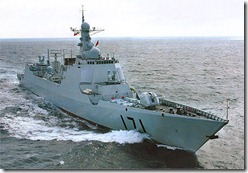ONI report: PLAN status
 The FAS strategic blog points out to a recent ONI report that is chock full of interesting material. FAS focused on the information that the new classes of Chinese SSNs & SSBNs are much noisier than previously estimated, but the report encompasses the totality of Chinese naval developments and future prospects. Aspects such as the modernisation of shore-based naval aviation, the status of the aircraft carrier program, the emergence of the ASBM threat and the new classes of surface warship and amphibious and replenishment forces are covered.
The FAS strategic blog points out to a recent ONI report that is chock full of interesting material. FAS focused on the information that the new classes of Chinese SSNs & SSBNs are much noisier than previously estimated, but the report encompasses the totality of Chinese naval developments and future prospects. Aspects such as the modernisation of shore-based naval aviation, the status of the aircraft carrier program, the emergence of the ASBM threat and the new classes of surface warship and amphibious and replenishment forces are covered.
The full report is available here, a recommended read for interested observers.
Bonus info: The ONI cosniders the Oscar-II class subs to be substantially quieter than the Akula I, though inferior to Akula II. DB authors take note!
Russian navy to get big budget boost
Ares reports that the Russian navy, and particular its submarine force, is to get the lion’s share of the defense budget in the forthcoming years.
[…] more than 40% of the Defense Ministry budget will be spent on the navy, with emphasis on strategic nuclear forces.
“It is much more than is being spent on strategic missile forces, space forces and the air force combined. It is hundreds of billions of rubles”, said Ivanov, adding that the navy funding will be mainly spent for strategic nuclear submarines.
The focus on submarines comes as little surprise for those who have been watching the Russian navy’s budget over the lean years of the 90s and early 2000s; even when the funds were reduced to a trickle, submarines would snatch almost all of it (this BTW explains, to a significant extent, the collapse of virtually the entire surface fleet).
What is a surprise is that, overall, the navy is getting a significantly larger chunk of the overall budget this time around. Traditionally (including most of the Soviet period) the bulk of the budget was shared between the Strategic Rocket Forces, the Army and the Air Force, with the Navy getting the leftovers. It is possible that this shift signals a realization, from the Russian leadership’s part, of the growing importance of the naval arm in light of the emerging importance of the Arctic regions, as well as the new opportunities for influencing the trade routes emanating from China (it will be particularly interesting to watch the division of assets between the Northern and Pacific fleets in the coming years).
Interesting times indeed.





